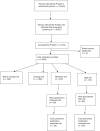Quantifying the effects of risk-stratified breast cancer screening when delivered in real time as routine practice versus usual screening: the BC-Predict non-randomised controlled study (NCT04359420)
- PMID: 37005486
- PMCID: PMC10066938
- DOI: 10.1038/s41416-023-02250-w
Quantifying the effects of risk-stratified breast cancer screening when delivered in real time as routine practice versus usual screening: the BC-Predict non-randomised controlled study (NCT04359420)
Erratum in
-
Correction To: Quantifying the effects of risk-stratified breast cancer screening when delivered in real time as routine practice versus usual screening: the BC-Predict non-randomised controlled study (NCT04359420).Br J Cancer. 2023 Jun;128(11):2140. doi: 10.1038/s41416-023-02273-3. Br J Cancer. 2023. PMID: 37095186 Free PMC article. No abstract available.
Abstract
Background: Risk stratification as a routine part of the NHS Breast Screening Programme (NHSBSP) could provide a better balance of benefits and harms. We developed BC-Predict, to offer women when invited to the NHSBSP, which collects standard risk factor information; mammographic density; and in a sub-sample, a Polygenic Risk Score (PRS).
Methods: Risk prediction was estimated primarily from self-reported questionnaires and mammographic density using the Tyrer-Cuzick risk model. Women eligible for NHSBSP were recruited. BC-Predict produced risk feedback letters, inviting women at high risk (≥8% 10-year) or moderate risk (≥5-<8% 10-year) to have appointments to discuss prevention and additional screening.
Results: Overall uptake of BC-Predict in screening attendees was 16.9% with 2472 consenting to the study; 76.8% of those received risk feedback within the 8-week timeframe. Recruitment was 63.2% with an onsite recruiter and paper questionnaire compared to <10% with BC-Predict only (P < 0.0001). Risk appointment attendance was highest for those at high risk (40.6%); 77.5% of those opted for preventive medication.
Discussion: We have shown that a real-time offer of breast cancer risk information (including both mammographic density and PRS) is feasible and can be delivered in reasonable time, although uptake requires personal contact. Preventive medication uptake in women newly identified at high risk is high and could improve the cost-effectiveness of risk stratification.
Trial registration: Retrospectively registered with clinicaltrials.gov (NCT04359420).
© 2023. The Authors.
Conflict of interest statement
JC and ARB report receiving royalty payments through Cancer Research UK for commercial use of the Tyrer-Cuzick algorithm. All other authors report no competing interests.
Figures
References
-
- Cancer Research UK. Breast cancer diagnosis and treatment statistics. http://www.cancerresearchuk.org/health-professional/cancer-statistics/st.... Accessed 6 Mar 2022.
-
- NHS Digital. Breast Screening Programme, England, 2016-17. https://digital.nhs.uk/catalogue/PUB30195. Accessed 6 Mar 2022.
Publication types
MeSH terms
Associated data
Grants and funding
LinkOut - more resources
Full Text Sources
Medical


